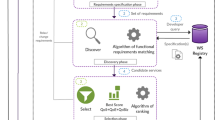Abstract
In this paper, we propose FECT, a new modelling framework for describing and composing heterogenous Web services to satisfy emergent requirements. In FECT, a three-dimension description pattern, i.e. the Environment, the Capability and the behavior Traces, has been proposed to describe Web services. FECT has the following features, which may distinguish it from other work. Firstly, the environment, with which Web services may interact, has been introduced for characterizing the context of Web services. Secondly, the capability of a Web service is captured as the effects on its environment. Thirdly, the composition process is accomplished by combining the traces of Web services.
This work was partly supported by the National Natural Science Foundation of China (No.60233010 and No.60496324), the National Key Research and Development Program (Grant No. 2002CB312004) of China, the Knowledge Innovation Program of the Chinese Academy of Sciences and MADIS of the Chinese Academy of Sciences.
Preview
Unable to display preview. Download preview PDF.
Similar content being viewed by others
References
Koehler, J., Srivastava, B.: Web service composition: Current solutions and open problems. In: ICAPS 2003 Workshop on Planning for Web Services, pp. 28–35 (2003)
Web services description language (WSDL) 1.1 (2001), http://www.w3.org/TR/wsdl
SOAP version 1.2. (2004), http://www.w3.org/TR/soap/
Ankolekar, A., et al.: DAML-S: Semantic markup for web services. In: Proceedings of the International Semantic Web Workshop (2001)
Weerawarana, S.: Business process with BPEL4WS: Understanding BPEL4WS (2002), http://www-106.ibm.com/
Hamadi, R., Benatallah, B.: A petri net-based model for web service composition. In: Proceedings of the 14th Australasian Database Conference (ADC 2003), pp. 191–200. Australian Computer Society (February 2003)
Milner, R.: A Calculus of Communication Systems. LNCS, vol. 92. Springer, Heidelberg (1980)
Parnas, D.L., Madey, J.: Functional documentation for computer systems. Science of Computer Programming 25(1), 41–61 (1995)
Jackson, M.: The meaning of requirements. Annals of Software Engineering 3, 5–21 (1997)
Jackson, M.: Problem Frames: Analyzing and structuring software development problems. Addison-Wesley, Reading (2001)
UDDI executive overview: Enabling service-oriented architecture (2004), http://uddi.org/pubs/
Jin, Z., Bell, D.A., Wilkie, F.G., Leahy, D.G.: Automated requirements elicitation: Combining a model-driven approach with concept reuse. International Journal of Software Engineering and Knowledge Engineering 13(1), 53–82 (2003)
Yu, E.S.K.: Towards modelling and reasoning support for early-phase requirements engineering, Washington D.C., USA, January 1997, pp. 6–8 (1997)
Hoare, C.A.R.: Communicating Sequential Processes. Prentice Hall INternationsl, Englewood Cliffs (1985-2004)
Web service choreography interface (WSCI) 1.0 (2002), http://www.w3.org/TR/wsci
Casati, F., et al.: Adaptive and dynamic service composition in eflow. In: Proc. of the International Conference on Advanced Information Systems Engineering (2000)
Benatallah, B., Sheng, Q.Z., Dumas, M.: The self-serv environment for web services composition. IEEE Internet Computing 7(1), 40–48 (2003)
Motta, E., Domingue, J., Cabral, L.: Irs-ii: A framework and infrastructure for semantic web services. In: Fensel, D., Sycara, K., Mylopoulos, J. (eds.) ISWC 2003. LNCS, vol. 2870, pp. 306–318. Springer, Heidelberg (2003)
Author information
Authors and Affiliations
Editor information
Editors and Affiliations
Rights and permissions
Copyright information
© 2005 Springer-Verlag Berlin Heidelberg
About this paper
Cite this paper
Hou, L., Jin, Z. (2005). FECT: A Modelling Framework for Automatically Composing Web Services. In: Fan, W., Wu, Z., Yang, J. (eds) Advances in Web-Age Information Management. WAIM 2005. Lecture Notes in Computer Science, vol 3739. Springer, Berlin, Heidelberg. https://doi.org/10.1007/11563952_29
Download citation
DOI: https://doi.org/10.1007/11563952_29
Publisher Name: Springer, Berlin, Heidelberg
Print ISBN: 978-3-540-29227-2
Online ISBN: 978-3-540-32087-6
eBook Packages: Computer ScienceComputer Science (R0)




